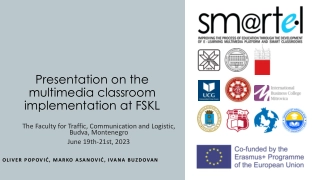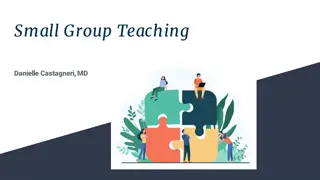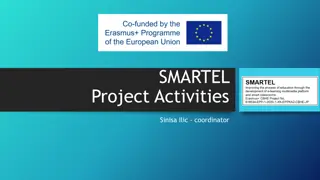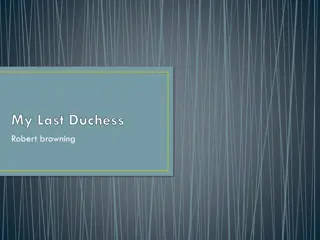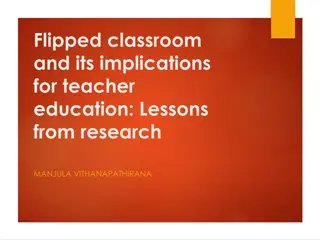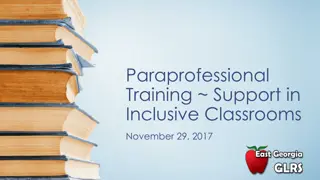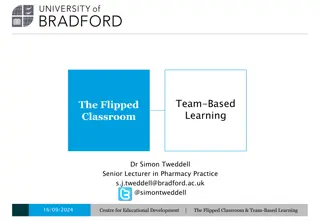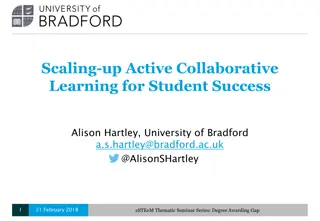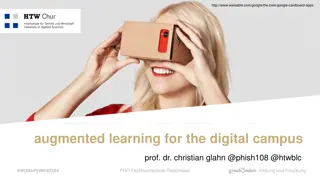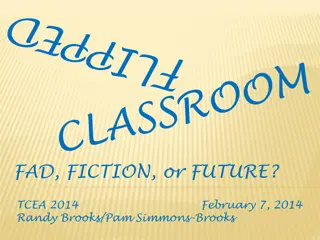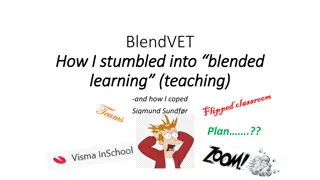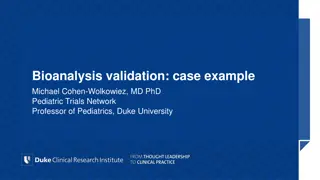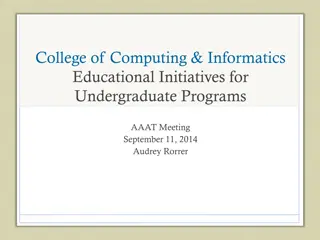Implementing Flipped Classrooms in Medical Education: A Case Study from Duke University
Flipped classrooms in medical education, exemplified by Duke University's unique curriculum, emphasize student-centered learning through active strategies like student presentations and online videos. This pedagogical approach aligns with adult learning styles and involves prelearning activities and diagnostic assessments to address learning gaps effectively.
Download Presentation

Please find below an Image/Link to download the presentation.
The content on the website is provided AS IS for your information and personal use only. It may not be sold, licensed, or shared on other websites without obtaining consent from the author.If you encounter any issues during the download, it is possible that the publisher has removed the file from their server.
You are allowed to download the files provided on this website for personal or commercial use, subject to the condition that they are used lawfully. All files are the property of their respective owners.
The content on the website is provided AS IS for your information and personal use only. It may not be sold, licensed, or shared on other websites without obtaining consent from the author.
E N D
Presentation Transcript
THE FLIPPED CLASSROOM AMERICAN SOCIETY OF HEMATOLOGY DECEMBER 6, 2015 GOW AREPALLY, MD DIVISION OF HEMATOLOGY ASSOCIATE PROFESSOR, MEDICINE
OUTLINE Definitions Flipped Classrooms Principles Duke University Medical School Case study: Duke Renal Physiology Curriculum Redesign
WHAT IS A FLIPPED CLASSROOM? Image: http://www.washington.edu/teaching/teaching-resources/engaging-students-in-learning/flipping-the-classroom/
FLIPPED CLASSROOM Outgrowth of student-centered learning environments Active learning strategies: student presentations, small group problem solving, self/peer evaluation, group discussions Inverted instructional approach using technology to move lectures out of classrooms Online video lectures prior to in-class sessions Allows self-paced online learning Interactive classroom time; differentiated learning
WHY FLIP? Aligns with adult learning styles (andragogy;M.Knowles) 1. Adults need to be involved in the planning and evaluation of their instruction. 2. Experience (including mistakes) provides the basis for the learning activities. 3. Adults are most interested in learning subjects that have immediate relevance and impact to their job or personal life. 4. Adult learning is problem-centered rather than content- oriented
IMPLEMENTING A FLIPPED CLASSROOM Using a backward instructional design to plan learning activities Creating opportunities for prelearning (short recordings) Developing diagnostic assessments to identify learning gaps Using technology to address learning gaps and develop competency
Medical School: Student Centered Learning & Use of Flipped Classrooms
BACKGROUND Duke unique medical school curriculum First year: basic sciences Second year: clinical sciences Third year: research Fourth year: clerkships Implementation of flipped classrooms ~ 5 years ago Team based learning methodology Pass/fail curriculum Colleen O Connor Grochowski, PhD Associate Dean for Curricular Affairs
DUKE: FIRST YEAR CURRICULUM Block Duration (weeks) Format Molecules, Cells and Tissues 6.5 lectures/TBL x3/labs Normal Body 12.5 Lectures/TBL x 4/Labs Brain & Behavior 4 Full TBL Body & Disease 20 Full Flipped Classroom (occasional lectures)
TEAM BASED LEARNING Prior to class: Assigned learning materials: readings, pre-recorded lectures and interviews with scientists and clinicians. Students assigned to teams for the year by medical school administration equalizing by gender/racial/academic abilities Classroom activities (2-3 hours): iRA: individual readiness assessment 5 minute quiz Closed book; counts towards grade tRA or gRA: same quiz team/group readiness assessment (closed book) Same quiz Closed book; counts towards grade Group application New minted knowledge applied Groups have to convince each other of correct answer
DUKES USEOF FLIPPED CLASSROOMS Utilize on-line 1 hour pre-recorded lectures or streaming lectures Loaded onto internal curriculum management system (Blue Docs) Discussed in small groups Quizzes every two weeks Content experts: guide on the side
MASTERYOF BRAIN & BEHAVIORCOURSECONTENT COMPAREDTOOTHERCOURSES Mastery of Content Same Mastery Better Mastery Less Mastery 9% 36% 55%
SURVEY: OVERALLTHEFLIPPEDCLASSROOMWORKED FORME 50% 44% 45% 40% 35% Strongly Agree 30% Agree 22% 25% Neutral 20% 15% Disagree 15% 11% Strongly Disagree 8% 10% 5% 0% Category 1
SURVEY: WHICHTYPEOFCURRICULUMWOULDYOU PREFERFORMOST 1ST & 2NDYEARCOURSES? Preference 65% 70% 60% 50% 40% 19% 30% 16% 20% Preference 10% 0% Entirely Lecture Based Mixed Flipped and Lecture Entirely Flipped
LESSONS LEARNEDFROM 5 YRS Online materials, quizzes, team based activities must be correlated/match content Questions need to be appropriate level for students Time for off-site learning must be counted Creating teams that are equal with respect to academic capabilities
WHAT LIES AHEAD @ DUKEMED? Increased reliance: on technology (apps) to individualize training on simulation technology Incorporating social media
DUKE NEPHROLOGY: CURRICULAR REDESIGN
INDIVIDUALIZED RENAL PHYSIOLOGY CURRICULUM Reasons for rethinking Nephrology curriculum: NRMP data 2009-2014: 44% decline in applicant pool to nephrology Non-renal fellows: renal disease too complicated Medical school renal physiology considered too difficult
Q-METHOD STATEMENT SETS 5 domains identified: Comprehension of renal physiology Relevance or renal physiology Learning preferences Course characteristics Interest in nephrology Roberts et. al., Adv Physiol Educ. 2015 Sep;39(3):149-57
37 Q-SORT QUESTIONS POSED Kidney is a black box I am a visual learner I would like to hear about kidney research I will likely care for renal patients Roberts et. al., Adv Physiol Educ. 2015 Sep;39(3):149-57
RESULTS Total of 113 students entering course given survey by e- mail 60 unique surveys collected (53% response rate) Mean rank score for each statement collected (-4 to +4) Highest rank scores (agree): by graduation, I should know how to interpret labs correctly : +2.55 Important for me to understand kidney : +2.28 Lowest rank scores (disagree): I can forget about kidney after this course : -2.78 Instructors don t enjoy teaching : -2.30 Roberts et. al., Adv Physiol Educ. 2015 Sep;39(3):149-57
FACTOR ANALYSIS Performed to see which viewpoints correlated together Three dominant themes revealed: Social-auditory learners: value attending class; satisfied with current lecture organization; improved learning through peer interactions Readers: value learning from textbook/notes; do not prefer to attend lectures; interactions during class not so helpful Visual learners: primarily prefers to learn from online videos, like learning in unique ways; however, often not feeling prepared for class
INDIVIDUALIZED RENAL PHYSIOLOGY CURRICULUM Lectures developed by individual lecturers Mini chapters written by individual lecturers Online video tutorials ( pen casts ) https://vimeo.com/channels/814792/98583516 Interactive in-class experiences In-class assignments Case discussions Simulation of content
TO FLIPOR NOTTO FLIP? Image source: http://www.teq.com/blog/2014/11/flipped-classroom-youve-started-flipping-now/#.VmCrOrgrJaQ
FLIPPING: ADVANTAGES Aligns with adult learning theory/student-centered learning Aligns with real world learning environments Self-paced learning Highly interactive/promotes peer to peer interactions/dialogue
FLIPPING: DISADVANTAGES Increased administrative coordination Requires curricular development teams to interface students and instructors Utilized technology Time intensive Need for creativity/not rehash Facile with technology Technology support Assess learning gaps Gauge student compliance
ACKNOWLEDGEMENTS Carol Grochowski, PhD, Associate Dean for Curricular Affairs Matt Velkey, PhD
IMPLEMENTATION STRATEGIES Provide opportunities for exposure prior to class Provide incentives to prepare for class Drawback: not all students watch videos Provide a mechanism to assess student understanding Drawback: students just click next and/or post questions to show compliance Provide clear connections between in-class and out of class activities Provide clearly defined and structured guidance Provide enough time for students to carry out assignments Provide facilitation for building a learning community
METHODS: ASSESSMENTOF LEARNERS http://www.wearerecurve.com/wp-content/uploads/2014/08/likert-scale.jpg?ed55ca Targeted assessment of learners Likert scales: Defined by the researcher Responses influenced by survey structure, question & response characteristics Systematic error Q-methodology : Borne out of social science research Measures subjectivity Subjects provide meaning to statements through a sorting procedure


